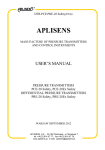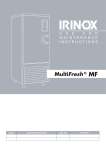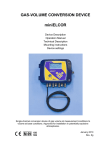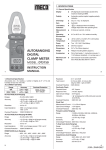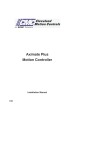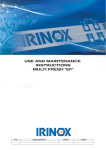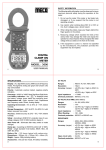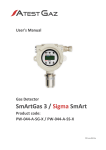Download Instruction Manual
Transcript
DTR.APC.APR/AL.01(ENG)
APLISENS
MANUFACTURE OF PRESSURE TRANSMITTERS
AND CONTROL INSTRUMENTS
USER’S MANUAL
INTRINSICALLY SAFE SMART PRESSURE TRANSMITTER
type: APC-2000EEx/AL
INTRINSICALLY SAFE SMART DIFFERENTIAL
PRESSURE TRANSMITTER type:
APR-2000EEx/AL
APR-2200EEx/AL
SMART PRESSURE TRANSMITTER
type: APC-2000/AL
SMART DIFFERENTIAL PRESSURE TRANSMITTER
type: APR-2000/AL, APR-2200/AL
WARSAW MARCH 2007
1
DTR.APC.APR.AL.01(ENG)
Symbols used
Symbol
i
Description
Warning to proceed strictly in accordance with the information contained in the
documentation in order to ensure the safety and full functionality of the device.
Information particularly useful during installation and operation of the device.
Information particularly useful during installation and operation of a type EEx device.
Information on disposal of used equipment
BASIC REQUIREMENTS AND SAFE USE
- The manufacturer will not be liable for damage resulting from incorrect installation,
-
-
-
-
failure to maintain the device in a suitable technical condition, or use of the device
other than for its intended purpose.
Installation should be carried out by qualified staff having the required authorizations to
install electrical and pressure-measuring devices. The installer is responsible for performing
the installation in accordance with these instructions and with the electromagnetic
compatibility and safety regulations and standards applicable to the type of installation.
The device should be configured appropriately for the purpose for which it is to be used.
Incorrect configuration may cause erroneous functioning, leading to damage to the device or
an accident.
In systems with pressure transmitters there exists, in case of leakage, a danger to staff on
the side where the medium is under pressure. All safety and protection requirements must
be observed during installation, operation and inspections.
If a device is not functioning correctly, disconnect it and send it for repair to the manufacturer
or to a firm authorized by the manufacturer.
In order to minimize the risk of malfunction and associated risks to staff, the device is not to be
installed or used in particularly unfavourable conditions, where the following dangers occur:
- possibility of mechanical impacts, excessive shocks and vibration;
- excessive temperature fluctuation, exposure to direct sunlight;
- condensation of water vapour, dust, icing.
Installation of intrinsic safety versions should be performed with particular care, in accordance
with the regulations and standards applicable to that type of installation.
The manufacturer reserves the right to make changes (not having a negative impact on the
operational and metrological parameters of the products) without updating the contents of the
technical manual
2
DTR.APC.APR.AL.01(ENG)
CONTENTS
I.
1.
2.
3.
4.
5.
APPENDIX Ex ...............................................................................................................................3
INTRODUCTION............................................................................................................................6
USER MATERIALS .......................................................................................................................6
APPLICATIONS AND MAIN FEATURES ......................................................................................6
IDENTIFYING MARKS. ORDERING PROCEDURE ......................................................................6
TECHNICAL DATA........................................................................................................................7
5.1. APC..., APR...- COMMON PARAMETERS ................................................................................................... 7
5.2. APC...- MEASUREMENT RANGES AND METROLOGICAL PARAMETERS. ........................................................... 8
5.3. APR-2000/AL- MEASUREMENT RANGES AND METROLOGICAL PARAMETERS. ................................................ 9
5.4. APR-2200/AL- MEASUREMENT RANGES AND METROLOGICAL PARAMETERS. ................................................ 9
6. CONSTRUCTION, PRESSURE CONNECTORS. ............................................................................. 10
6.1. MEASUREMENT PRINCIPLES, ELECTRONIC SYSTEM. .................................................................................10
6.2. CONSTRUCTION. ...................................................................................................................................10
6.3. CASING, ELECTRICAL CONNECTIONS .......................................................................................................10
7.
PLACE OF INSTALLATION OF TRANSMITTERS...................................................................... 11
7.1. GENERAL RECOMMENDATIONS ................................................................................................................11
7.2. LOW AMBIENT TEMPERATURE. ................................................................................................................11
7.3. HIGH MEDIUM TEMPERATURE. ................................................................................................................11
7.4. MECHANICAL VIBRATION, CORROSIVE MEDIA. ..........................................................................................12
8.
INSTALLATION AND MECHANICAL CONNECTIONS............................................................... 12
8.1. APC... INSTALLATION AND CONNECTIONS ................................................................................................12
8.2. APR... INSTALLATION AND CONNECTIONS ................................................................................................12
9.
ELECTRICAL CONNECTION...................................................................................................... 13
9.1. GENERAL RECOMMENDATIONS ................................................................................................................13
9.2. ELECTRICAL CONNECTIONS FOR APC..., APR... .......................................................................................13
9.3. PROTECTION FROM EXCESS VOLTAGE ......................................................................................................13
9.4. EARTHING ............................................................................................................................................14
10.
SETTING AND REGULATION..................................................................................................... 14
10.1. TRANSMITTER RANGE, DEFINITIONS ......................................................................................................14
10.2. CONFIGURATION AND CALIBRATION .......................................................................................................14
11.
INSPECTIONS AND SPARE PARTS. ......................................................................................... 19
11.1. PERIODIC INSPECTIONS ........................................................................................................................19
11.2. UNSCHEDULED INSPECTIONS ................................................................................................................19
11.3. CLEANING THE DIAPHRAGM SEAL, OVERLOADING DAMAGE ......................................................................19
11.4. SPARE PARTS......................................................................................................................................19
12.
13.
14.
15.
PACKING, STORAGE AND TRANSPORT.................................................................................. 19
GUARANTEE .............................................................................................................................. 19
ADDITIONAL INFORMATION ..................................................................................................... 20
FIGURES ..................................................................................................................................... 20
FIGURE 1. APC...,APR... TRANSMITTERS – BLOCK DIAGRAM. ...........................................................................20
FIGURE 2. ELECTRICAL CONNECTIONS FOR APC...,APR... TRANSMITTERS.........................................................21
FIGURE 3. APC-2000/AL PRESSURE TRANSMITTER.........................................................................................22
FIGURE 4. CONFIGURATION OF THE APC..., APR.... TRANSMITTER USING MAGNETS. ..........................................22
FIGURE 5. M-TYPE CONNECTOR WITH M20X1.5 THREAD ..................................................................................23
FIGURE 6. P-TYPE CONNECTOR WITH M20X1.5 THREAD...................................................................................23
FIGURE 7. CM30X2-TYPE CONNECTOR WITH FLUSH DIAPHRAGM WITH M30X2 THREAD .......................................23
FIGURE 8. PROCESS CONNECTIONS G1/2” AND G1”. .......................................................................................24
FIGURE 9. APR-2000/AL DIFFERENTIAL PRESSURE TRANSMITTER WITH C TYPE VENTED COVERS. .......................25
FIGURE 10. APR-2000/AL DIFFERENTIAL PRESSURE TRANSMITTER WITH A SINGLE DIRECT DIAPHRAGM SEAL
(EXAMPLE). ......................................................................................................................................25
FIGURE 11. EXAMPLE: HOW TO INSTALL THE APR-2200/AL TRANSMITTERS WITH REMOTE DIAPHRAGM.................26
FIGURE 12. EXAMPLE: HOW TO INSTALL THE APR-2000/AL TRANSMITTER ON A VERTICAL OR HORIZONTAL PIPE. ...27
FIGURE 13. EXAMPLE: HOW TO INSTALL THE APR-2000/AL TRANSMITTER WITH A VALVE MANIFOLD TO A 2” PIPE...27
FIGURE 14. APR-2200/AL DIFFERENTIAL PRESSURE TRANSMITTER WITH TWO REMOTE DIAPHRAGM SEALS
(EXAMPLES). ....................................................................................................................................28
FIGURE 15. APR-2200/AL DIFFERENTIAL PRESSURE TRANSMITTER WITH DIRECT DIAPHRAGM SEAL AND REMOTE
DIAPHRAGM SEAL (EXAMPLES)............................................................................................................28
FIGURE 16. EXAMPLE: HOW TO INSTALL THE APC..., APR... TRANSMITTER ........................................................29
FIGURE.17. ADDITIONAL EQUIPMENT FOR FITTING OF PRESSURE TRANSMITTERS.................................................30
3
I.
DTR.APC.APR.AL.01(ENG)
APPENDIX Ex
DTR.APC.APR.AL(ENG)
Appendix Ex
1453
SMART PRESSURE TRANSMITTER type APC–2000EEx/AL,
SMART DIFFERENTIAL PRESSURE TRANSMITTERS
type APR-2000EEx/AL, APR-2200EEx/AL
EEx VERSIONS
1. Introduction
1.1. This “Appendix Ex.01” applies only to transmitters of types APC-2000EEx/AL, APR-2000EEx/AL,
APR-2200EEx/AL in EEx versions, marked on the rating plate as shown in 2.2 and denoted EEx
in the Product Certificate.
1.2. The appendix contains supplementary information relating to the EEx versions of these transmitters.
During installation and use of EEx transmitters, reference should be made to DTR.APC.APR/AL.01(ENG) in
conjunction with “Appendix Ex.01”.
2. Use of APC-2000EEx/AL, APR-2000EEx/AL, APR-2200EEx/AL transmitters
in danger zones.
2.1. The transmitters are produced in accordance with the requirements of the following standards
PN-EN 50014:2004, PN-EN 50020:2003(U), PN-EN 50284:2004
2.2. The transmitters may operate in areas where there is a risk of explosion, in accordance with the rating of
the explosion protection design:
II 1/2G EEx ia IIC T5/T6 (rating for industrial uses),
FTZÚ 05 ATEX 0056X
(certificate number).
T5/T6 mark means that the temperature class is T5 or T6 depending on the working temperature of the
transmitter, i.e. T6 for Ta ≤ 40°C or T5 for 40°C < Ta ≤ 65°C, and with power supply with rectangular
characteristics, T6 for Ta ≤ 40°C, T5 for 40°C < Ta ≤ 80°C.
2.3. Transmitter category and hazard areas
The category 1/2G, contained within the rating, means that the transmitter may be installed within a type 1
or 2 hazard zone. The APC-2000EEx/AL, APR-2000EEx/AL, APR-2200EEx/AL process connections may
connect to a type 0 zone (see the diagram below for an example).
Zone 0
Zone 1 or 2
Safe area
Pressure transmitter
or differential
pressure transmitter
3. Identifying marks.
Intrinsically safe transmitters must have a rating plate containing the information specified in paragraph 4 of
DTR.APC.APR/AL(ENG) and also at least the following:
-
-
CE mark and number of notified unit:, ,
mark
designation of explosion protection design, certificate number
values of parameters such as. Ui, Ii, Pi, Ci, Li
marking of electrical and process connections
year of manufacture
4
DTR.APC.APR.AL.01(ENG)
DTR.APC.APR.AL(ENG)
Appendix Ex
4. User information.
Together with the transmitters ordered, the user will receive: User’s
DTR.APC.APR/AL.01(ENG) with Appendix Ex, and also the Product Certificate.
Manual
numbered:
5. Permitted input parameters (based on data from the FTZÚ 05 ATEX 0056X
certificate, and certification documentation).
The transmitters should be powered via the associated power feeding and measurement devices
provided with the relevant intrinsic-safe certificates. The parameters of their outputs to the danger zone
should not exceed the limit power supply parameters for the below specified transmitters.
5.1 - for power supply with a linear characteristic”
Ui = 28V Ii = 0,093A Pi = 0,65W for Ta ≤ 40°C i T6 and for 40°C < Ta ≤ 65°C and T5
Power supply with a “linear” characteristic may be e.g. a typical barrier with parameters
Uo = 28V Io = 0.093A Rw = 300Ω.
Ii
Rw
ID
transmitter
Io
Uo
Fig.1. Power supply from a source with “linear” characteristic
5.2. - for power supply with a “trapezial” characteristic
Ui = 24V Ii = 0,075A Pi = 0,65W
for Ta ≤ 40°C and T6 and for 40°C < Ta ≤ 65°C and T5
Example of power supply from a source with “trapezial” characteristic (see Fig. 2).
transmitter
Ii
Io
Ui
Rw
Uo
ID
Uq
Fig. 2. Power supply from a source with “trapezial” characteristic
Uq
If Uo <
2
then parameters Uq, Ii, Pi are interrelated as follows:
Uq2
4Pi
Uq
Uq =
,
Rw =
,
Pi = 4Rw
Ii
Ii
5.3. - for power supply with “rectangular” characteristic
Ui = 24V Ii = 0,025A Pi = 0,60W for Ta ≤ 40°C and T6, for 40°C < Ta ≤ 80°C and T5
The supply of power from a source with a “rectangular” characteristic means that the voltage of the EEx
power supply remains constant until current limitation activates.
The protection level of power supplies with a “rectangular” characteristic is normally “ib”.
The transmitter powered from such a supply is also a EEx device with protection level “ib”.
Example of practical provision of power supply.
– use a stabilized power supply with Ui=24V with protection level „ib” and current limited to Ii=25mA.
5.4. Input inductance and capacity
Ci = 20nF,
Li = 1,18mH
5
DTR.APC.APR.AL.01(ENG)
DTR.APC.APR.AL(ENG)
Appendix Ex
6. How to connect EEx transmitters APC-2000EEx/AL, APR-2000EEx/AL,
APR-2200EEx/AL.
The transmitter and other devices in the measuring loop should be connected in accordance
with the intrinsic-safety and explosion-safety regulations and the conditions for use in
dangerous areas.
Failure to observe the intrinsic-safety regulations can cause explosion and the resulting hazard
to people.
Hazardous area
Safe area
milliammeter
mA
+
_
TEST
+
Ro ≥ 250Ω
_ TEST
_
+SIGNAL
a EEx power sapply
see p.5..
250 Ω
F1
PF
ABC
To measure the current in the transmitter without
disconnecting the signalling circuit, connect
a milliammeter to control sockets TEST+, TEST-.
In hazardous areas, connections
to the control terminals must be
made using only instruments which
are permitted to be used in such areas.
F2
F3
F4
RE
PV
F4
GHI
@%&
DE F
7
8
9
0
JKL
MNO
P QR
+/
4
5
6
S TU
V WX
YZ#
1
2
3
*
.
Communicator or
converter RS-Hart
Communicator certified for connection
to a signal line leading to a danger zone.
In the absence of such a certificate,
the transmitter should be configured
and calibrated within a safe zone.
7. Basic requirements according to EN 50039 for type A and B leads used to
connect the transmitter to the power supply and measurement circuit.
7.1. Thickness of insulation according to type of material, but not less than 0.2mm.
7.2. Insulation strength:
- 2UN but not less than 500VAC for the wire
- 500VAC between the cable screen and the connected wires;
- 1000VAC between two groups of wires, each of which contains half the connected wires of the cable.
7.3. Multiwire cable must not carry any circuit which is not a intrinsically safe circuit.
7.4. The cable must not carry circuits with a maximum voltage exceeding 60V.
7.5. The cables should be protected from damage, for example using channels, shielding pipes, cable racks,
durable fastenings etc.
i
It is not permitted to repair or otherwise interfere with the transmitter’s electrical circuits in any
way. Damage and possible repair may be assessed only by the manufacturer or another
authorized party.`
6
1.
DTR.APC.APR.AL.01(ENG)
INTRODUCTION
1.1. This manual is intended for users of non-intrinsic-safe versions APC-2000/AL smart pressure transmitters
and APR-2000/AL, APR-2200/AL smart differential pressure transmitters and intrinsic-safe versions APC2000EEx/AL smart pressure transmitters and APR-2000EEx/AL, APR-2200EEx/AL smart differential pressure
transmitters, containing the data and guidelines necessary to understand the functioning of the transmitters and
how to operate them.
It includes essential recommendations concerning installation and use, as well as emergency procedures.
1.2. The parameters and information specified for transmitters identified herein with the sign APC...,
APR... also apply to transmitters APC-2000/AL, APR-2000/AL and their explosion-proof versions
identified as APC-2000EEx/AL, APR-2000EEx/AL as well as all the variations differing by the type of
the process terminals.
1.3. Information on the transmitter sizes and the method of installation apply to both, the intrinsic-safe and nonintrinsic-safe transmitters.
1.4. Technical data for the diaphragm seals and for the APC... and APR... transmitters are contained in the
catalogue cards “DIAPHRAGM SEALS”.
1.5. The APC–2000/AL, APR-2000/AL, APC–2000EEx/AL, APR-2000EEx/AL transmitters are also made in a
version which complies with the PED pressure directive, meet the requirements for category IV, and then carry
additional markings as in 4.3. and 4.4.
1.6. The transmitters comply with the requirements of EU directives as shown on the plate and with the relevant
Declaration of Conformity.
1.7. Additional data on APC-2000EEx/AL, APR-2000EEx/AL, APR-2200EEx/AL transmitters in EEx
versions covered by the EU-type test certificate number FTZÚ 05 ATEX 0056X is contained in the
appendix designated DTR.APC.APR/AL(ENG). Appendix Ex.
During installation and use of the transmitters in EEx version, reference should be made to
DTR.APC.APR/AL(ENG) in conjunction with Appendix Ex.01.
i
2.
USER MATERIALS
Transmitters are delivered in single and/or multiple packs.
A transmitter is delivered together with a “Product Certificate” which also serves as a guarantee card.
A batch of transmitters is supplied together with the Technical Manual (DTR).
At the customer’s request, a “Declaration of Compliance” and/or Certificate will be supplied.
3.
APPLICATIONS AND MAIN FEATURES
3.1. The APC... smart pressure transmitter are designed to measure positive gauge pressure, vacuum pressure
and absolute pressure of gases, vapours and liquids (including corrosive substances).
Differential pressure transmitters type APR–2000/AL are used to measure liquid levels in closed tanks, with
static pressure of up to 25MPa or 32MPa for special versions and to measure differential pressure across
constrictions such as filters and orifices.
3.2. The transmitters may be fitted with a range of types of process connectors, which enables them to
be used in a variety of conditions such as thick or highly reactive media, high and low temperatures,
etc.
3.3. APC..., APR... transmitters generate a 4...20mA output signal and a digital communication signal in a twowire system. The use of smart electronics enables regulation of the zero point, the measurement range,
damping, radical conversion characteristic and other functions using an Aplisens KAP communicator or from a
PC using a Hart/RS232 converter and Aplisens “Raport-01” configuration software.
i
4.
IDENTIFYING MARKS. ORDERING PROCEDURE
4.1. Every transmitter carries a rating plate containing at least the following information: CE mark, numbers of
notified institutions and designations of certificates obtained, name of manufacturer, type, factory number,
basic range, min. set range, static pressure limit, output signal, power supply voltage
Version types and the method of specifying the desired product when ordering are described in the current
“Information Cards” and the Catalogue.
7
i
5.
DTR.APC.APR.AL.01(ENG)
4.2. APC...APR...-transmitters in version: EEx approval have additional markings as described in
DTR.APC.APR.AL.01(ENG) Appendix Ex.01.
4.3. The rating plates of transmitters of type APC-2000/AL in versions compliant with the PED pressure
directive contain the notified unit number 0062 next to the CE mark, as well as the designations
of certificates number: CE-PED- H1D-APL003-04-PL.
4.4. The rating plates of transmitters of type APR-2000/AL in versions compliant with the PED pressure
directive contain the notified unit number 0062 next to the CE mark, as well as the designations
of certificates number: CE-PED- H1D-APL 002-05-PL.
TECHNICAL DATA.
5.1. APC..., APR...- Common parameters
5.1.1. APC..., APR... Electrical parameters
Power supply for non-intrinsic-safe versions
10,5 ÷ 36V DC, rated 24V DC
APC..., APR.... without illumination
10,5 ÷ 36 V DC
APC..., APR.... with illumination
13,5 ÷ 36 V DC
Power supply for intrinsic-safe versions
APC-2000EEx/AL, APR-2000EEx/AL, APR-2200EEx/AL in accordance with Appendix Ex.
Output signal
4÷20mA or inverse 20÷4mA set from communicator
Communication
Communication takes place via a 4÷20mA signal using specialized
Aplisens equipment, (see. 10.2.4).
Resistance required for communication
250÷1100Ω
Load resistance
RLmax[Ω] =
Usup[V]-10,5V*)
x 0,85
0,02A
Minimum supply voltage
Umin [V] =
RL[Ω] x 0,02A
+10,5V*)
0,85
for specified load resistance RL[Ω]
Time for stabilization of output signal
0,3s (for APC...)
Time for stabilization of output signal
0,5s (for APR...)
Additional electronic damping
0...30s
Voltage for insulation testing
500 VAC or 750 VDC, see p.9.3.
Excess voltage protection
see p.9.3.
*) 13,5 for APR–2000/AL, APR–2200/AL with illumination
5.1.2. APC..., APR... Permitted environmental conditions
Operating temperature range
-40°C ÷ 85°C (ambient temperature) also
APC–2000/AL, APR–2000/AL with illumination
(Operating temperature range for intrinsic-safe versions in accordance with Appendix Ex
Medium temperature range
-40°C ÷ 120°C – direct meas urement,
over 120°C measurement with the use of a transmissi on
tube or diaphragm seal.
Medium temperature range APR-2000/AL to 100°C for ve rsion compliant with the PED pressure directive.
Thermal compensation range
-25º ÷ 80ºC,
(-5º ÷ 65ºC for range – n°12 APC...)
(-40º ÷ 80ºC for special version APC...)
Relative humidity
0% ÷ 90%
Vibration during operation
not recommended
Exposure to direct sunlight
not recommended
5.1.3. APC..., APR... Construction materials
Diaphragm seal for APC...
Diaphragm seal for APR...
Sensing module
Liquid filling the interior the sensing module
Connectors for APC...
Stainless steel 316L (00H17N14M2) or Hastelloy C276
Hastelloy C276
Stainless steel 316L (00H17N14M2)
Silicone oil, chemically inactive liquid for measurement of
oxygen.
Stainless steel 316L (00H17N14M2) or
Hastelloy C276 only for P, GP, CM30x2
8
DTR.APC.APR.AL.01(ENG)
C-type vented covers and connectors for APR...
Stainless steel 316L (00H17N14M2)
Electronics casing
High pressure cast of aluminium alloy, lacquered with
chemical-resistant oxide enamel, colour yellow (RAL 1003).
5.1.4. APC..., APR... Ingress Protection Rating of Case IP65 wg. PN-EN 60529:2003.
5.2. APC...- Measurement ranges and metrological parameters.
5.2.1. APC..., Measurement ranges
N°
Basic range
(FSO)
Minimum set range
1.
2.
3.
4.
5.
6.
7.
8.
9.
10.
11.
12.
13.
14.
15.
16.
0...30 MPa
300
kPa
0...7
MPa
70
kPa
0...2,5 MPa
25
kPa
0...0,7 MPa
7
kPa
-100...150 kPa
12
kPa
0...200 kPa
10
kPa
0...100 kPa
5
kPa
-50...50 kPa
5
kPa
0...25 kPa
2,5 kPa
-10...10
kPa
2
kPa
-1,5...7
kPa*
0,5 kPa
-0,7...0,7 kPa*
0,1 kPa
0...110 kPa (abs.press.)
5
kPa
0...700 kPa (abs.press.)
7
kPa
0...2,5 MPa (abs.press.)
25
kPa
0...7
MPa (abs.press.)
70
kPa
* - only for transmitters without diaphragm seal,
Overpressure
limit (without
hysteresis)
0...29,7 MPa
45 MPa
0...6,93 MPa
14 MPa
0...2,475 MPa
5 MPa
0...0,693 MPa
1,4 MPa
-100...138 kPa
400 kPa
0...190 kPa
400 kPa
0...95 kPa
200 kPa
-50...45 kPa
200 kPa
0...22,5 kPa
100 kPa
-10...8
kPa
100 kPa
-1,5...6,5 kPa
50 kPa
-0,7...0,6 kPa
50 kPa
0...105 kPa(abs.press.)
200 kPa
0...693 kPa (abs.press.)
1,4 MPa
0...2,475MPa (abs.press)
5 MPa
0...6,93 MPa (abs.press)
14 MPa
(Other ranges available upon agreement)
Ability to shift the start of
the range
5.2.2. APC..., Metrological parameters
Accuracy
Long term stability
(for the basic range)
Error due to supply voltage changes
Thermal error
Thermal error for the whole thermal
compensation range
max ± 0,075% for the basic range
(max ± 0,16% for range n°12).
≤ accuracy for 3 years
max ± 0,002%(FSO)/1V
max ± 0,08%(FSO)/10ºC
(max ± 0,1% FSO/10°C for range n°10, 11, 12).
max ± 0,25%(FSO)
(max ± 0,4% FSO/10°C for range n°10, 11, 12
5.2.3. APC..., Pressure Connectors
M-type connector with M20x1.5 thread – see figure 5a,
P-type connector with M20x1.5 thread – see figure 6a,
CM30x2-type connector with flush diaphragm – see figure 7a,
G1/2 -type connector with G1/2” thread – see figure 8a,
GP -type connector with G1/2” thread,
CG1-type connector with G1” thread and flush diaphragm – see figure 8e,
other connection types by arrangement.
9
DTR.APC.APR.AL.01(ENG)
5.3. APR-2000/AL- Measurement ranges and metrological parameters.
5.3.1. APR-2000/AL, Measurement ranges
N°
1
2
3
4
5
6
Basic range
(FSO)
0...1,6 MPa
0...200 kPa
0...100 kPa
0...25 kPa
-0,5...7 kPa
-50...+50 kPa
Minimum set range
160 kPa
20 kPa
7 kPa
1 kPa
0,4 kPa
10 kPa
Ability to shift the start of
the range
0...1440 kPa
0..180 kPa
0...93 kPa
0...24 kPa
-0,5...6,6 kPa
-50...+40 kPa
Overpressure
limit
Static pressure
limit
25, 32MPa
(4MPa for P-type connector)
(25MPa for version compliant
with the PED pressure
directive)
4MPa
Other ranges available upon agreement.
Range n° 6 recommended for measurement of levels
with a direct mount diaphragm seals and a filled (or empty) impulse line.
5.3.2. APR-2000/AL, Metrological parameters
Accuracy
Long term stability
(for the basic range)
Error due to supply voltage changes
Thermal error
Thermal error for the whole thermal
compensation range
Zero shift error for static pressure*
max ± 0,075% for the basic range
≤ accuracy for 3 years
max ± 0,002%(FSO)/1V
max ± 0,08%(FSO)/10ºC
max ± 0,3%(FSO)
max ± 0,08 % (FSO)/1MPa
max ± 0,01 % (FSO)/1MPa (for range n°4)
max ± 0,03 % (FSO)/1MPa (for range n°5)
Cut-off on radical characteristic curve
cut-off of up to10% of flow.
* This error can be eliminated by zeroing the transmitter in static pressure conditions with zero differential
pressure.
5.3.3. APR-2000/AL, Pressure Connectors
APR-2000/AL without diaphragm seals – C-type connector to mount together with a valve manifold see fig.9.
APR-2000/AL with single direct diaphragm seal – as in the example (figure 10) or with other diaphragm seals in
accordance with catalogue cards “DIAPHRAGM SEALS”.
5.4. APR-2200/AL- Measurement ranges and metrological parameters.
5.4.1. APR-2200/AL, Measurement ranges
Basic range
(FSO)
Minimum set
range
-16...16 kPa
-50...50 kPa
-130...200 kPa
-130...1600kPa
0,1 mH2O
0.5 mH2O
1,5 mH2O
100 kPa
Vertical spacing Maximum configurable range dependent
on the actual vertical spacing of
of diaphragm
seals.
diaphragm seals. (m)
[1,6+( vertical spacing of sealsx94)]mH2O
≤ 1,7m
[5+(vertical spacing of sealsx1,04)]mH2O
[20+(vertical spacing of sealsx1,04)]mH2O
≤ 12m
1600kPa
≤ 12m
Static
pressure
limit
4MPa
4MPa
4MPa
4MPa
5.4.2. APR-2200/AL, Metrological parameters
Accuracy
Thermal error
Thermal error for the whole thermal compensation range
Zero shift error for static pressure
Error related to changes of Usup.
Additional errors due to effects of sealing
i
± 0,1% (FSO)
± 0,08 % (FSO) / 10°C
± 0,3 % (FSO)
± 0,08 % (FSO) / 1MPa
± 0,002 % (FSO) / V
see catalogue cards “DIAPHRAGM SEALS”.
The maximum vertical diaphragm seal spacing shown in the table applies to level measurement,
ensuring that it is possible to set the zero point of the transmitter when the tank is empty.
For measurements of density or phase boundaries (in the sugar and chemical industries and in
refineries) the vertical spacing of the diaphragm seals can be larger.
10
DTR.APC.APR.AL.01(ENG)
5.4.3. APR-2200/AL. Pressure Connectors - diaphragm seals – see catalogue cards
“DIAPHRAGM SEALS”.
6. CONSTRUCTION, PRESSURE CONNECTORS.
6.1. Measurement Principles, Electronic System.
APC... electronic pressure transmitters and APR... electronic differential pressure transmitters work by
converting changes in the resistance of a piezoresistant bridge, which are proportional to the pressure
difference being measured, into a standard current signal.
The active sensing element is a silicon diaphragm with in-diffused piezoresistors, separated from the medium
by a sealing diaphragm and manometric fluid.
The electronic system digitally processes the measurement signal and generates output signals: an analogue
4÷20 mA signal and a digital communication signal.
A block diagram of the transmitter is presented in Figure 1. In the input circuit two analogue signals are formed,
reflecting the measured pressure and the temperature of the sensing module. These signals are digitalized and
input to a microprocessor which controls the transmitter’s operation. Using data input during the production
process adjusts for thermal errors and carries out linearization.
After processing, the digital signal is again converted into an analogue 4÷20mA current signal, with
a superimposed digital communication signal.
For communication with the transmitter via the signal line a special Aplisens KAP communicator, or a computer
meeting the requirements given in 10.2.4, is used.
The transmitter’s input point is fitted with a noise filter and elements protecting against excess voltage..
6.2. Construction.
The main components of the smart pressure transmitter are the sensing module, in which the pressure signal is
converted into a non-uniformized signal, and the electronic system, which converts the signal from the sensing
module into a 4...20mA output signal and produces a digital communication signal.
6.2.1. In the APC... transmitters the pressure connectors may be attached to the sensing module as in figures
5a, 6a, 7a, 8 and other.
They are equipped with a diaphragm separating the internal part of the head from the medium.
6.2.2. In the APR–2000/AL transmitters, the sensing module has two P-type connectors, or C-type connecting
covers for installation on a valve manifold (figure 9).
6.2.3. For measuring the pressure of dense, chemically reactive or hot media, the transmitter may be
additionally fitted with various types of diaphragm seal depending on the type of medium and the
conditions in which measurement is carried out (see catalogue cards “Diaphragm Seals).
The diaphragm seal transmits the pressure obtained from the medium. The pressure is transmitted via
a manometric fluid which fills the space between the diaphragm of the seal and the diaphragm of the
sensing module. In the case of remote diaphragm seals, pressure is transmitted via a capillary linking
the transmitter’s sensing module to the diaphragm seal.
The construction of the seals depends on the medium properties and operating conditions for which
they are intended.
Technical data relating to the diaphragm seals’ dimensions and operating conditions can be found in
catalogue cards “DIAPHRAGM SEALS”.
6.2.4. The APR–2000/AL transmitters may be fitted with an single direct diaphragm seal, mounted on the “+”
pressure input of the sensing module, while the “–” input is a ¼NPT socket (figure 10).
i
The APR–2200/AL transmitter is fitted with two diaphragm seals and can be produced in two versions:
with one direct diaphragm seal and one remote diaphragm seal (figure 15);
with two remote diaphragm seals (figure 14).
6.3. Casing, Electrical Connections
The APC..., APR... transmitters have a casing made from high-pressure cast of aluminium alloy, giving o IP-65
protection.
The housing is provided with two screwed-on covers: one closed with a cavity and a feeder box, the other cover
can have a glass allowing to use a point display, the display has a 90° turning angle, the turn of the housing in
relation to the sensor from 0 to 355°, the directio n of the cable input can be chosen.
6.3.1. The transmitter is provided with a built-in LCD display.
Using the specific manufacturer’s commands it is possible to perform the following operations on the display:
●
display the output value in percents or in the user’s units (in accordance with the current configuration, i.e.
range, suppression, conversion curve),
11
DTR.APC.APR.AL.01(ENG)
●
rotate the displayed values by 180°
●
normal display and display in the negative.
●
adjust brightness
●
change the position of the decimal point
The LCD display includes a graphic display allowing to illustrate the measured value in percentage of the set
output range.
The not intrinsic-safe versions of transmitters APC..., APR... are provided with a display with additional
highlighting function. The function can be switch ON and OFF by the user using switch no. 1 on the display
panel.
ON position means that the highlight function is OFF.
7. PLACE OF INSTALLATION OF TRANSMITTERS
7.1. General recommendations
7.1.1. The smart pressure transmitter and differential pressure transmitter can be installed both indoors and
outdoors. It is recommended that transmitters intended for outdoor use be placed in a box or under cover.
7.1.2. The place of installation should be chosen in such a way as to allow access to the device and to protect it
from mechanical damage. In planning the installation of the transmitter and configuration of the impulse lines,
attention should be paid to the following requirements:
i
- The impulse lines should be as short as possible, with a sufficiently large cross-section, and free of
sharp bends, in order to prevent blockages;
- Where the medium is a gas, the transmitters should be installed above the measuring point, so that
condensation flows down towards the site of the pressure measurement; where the medium is a liquid
or where a protective liquid is used, the transmitters should be installed below the place where the
pressure measurement is taken;
- The impulse lines should be inclined at a gradient of at least 10cm/m;
- The levels of filling liquid in the impulse lines should be equal or kept constant difference,
- The configuration of the impulse lines and the valve connection system should be chosen with regard
to the measurement conditions and to requirements such as the need to reset the transmitters in
position and the need for access to the impulse lines during water or gas removal and flushing.
7.1.3. Where there is a risk of heavy objects hitting the instrument (resulting, in extreme cases, in
a part of the system with transducers being torn off and medium leakage), appropriate means of
protection should be applied for safety reasons and to avoid the possibility of sparkling or other,
more appropriate location should be selected for the transmitter.
7.1.4. Attention should also be paid to possible installation faults which may lead to measurement errors, such
as connections which are not tight, sediment blockage in lines which are too narrow, gas bubbles in a liquid line
or liquid column in a gas line etc.
7.2. Low Ambient Temperature.
When the solidification point of the liquid whose pressure is being measured is greater than the
ambient temperature, steps should be taken to protect the measurement apparatus from freezing
effects.
This is particularly important in the case open-air installations.
Protection is obtained by filling the impulse lines with a mixture of ethylene glycol and water, or another liquid
whose solidification point does not exceed the ambient temperature. Thermal insulation can protect the casing
of the transmitter and lines only from brief exposure to low temperatures. Where the temperature is very low,
the transmitter and impulse lines are should be heated.
7.3. High Medium Temperature.
The APC..., APR... transmitters may be used to measure media with temperatures of up to 120°C.
To protect the sensing module from temperatures in excess of 120ºC, suitably long impulse lines are used to
disperse the heat and to lower the temperature of the module.
Where it is not possible to use impulse lines of the required length, APC..., APR... transmitters with remote
diaphragm seals should be used (see catalogue cards “DIAPHRAGM SEALS”).
Data as per Appendix Ex.01 apply for the EEx version (the temperature of the electronic
subassembly cannot exceed +65°C).
12
DTR.APC.APR.AL.01(ENG)
7.4. Mechanical Vibration, Corrosive Media.
7.4.1. The transmitter should be installed in a place which is free of vibrations. If vibrations are carried to the
transmitter via the impulse lines, use should be made of elastic lines or a APC..., APR... transmitters with a
remote diaphragm seal.
7.4.2. Transmitters should not be installed in places where the diaphragm, made of 316L steel
00H17N14M2), would be subject to corrosion by the medium being measured
If possible, transmitters with diaphragms made of Hastelloy C276 should be used, or other means of
protection applied (e.g. in the form of a separating liquid) or transmitters with diaphragm seals adapted
for measuring aggressive mediums according to catalogue cards “DIAPHRAGM SEALS”) should be used.
8.
i
INSTALLATION AND MECHANICAL CONNECTIONS
The APC..., APR... transmitters can operate in any position.
When installed on an object with a high-temperature medium, it is advantageous to mount the transmitter
in a horizontal position with the packing gland pointing downwards or to the side, in such a way that the
transmitter is kept away from the stream of rising hot air.
When the measurement range is small, the reading can be affected by the position of the transmitter and
by the configuration of the impulse lines and the way in which they are filled with liquid.
This error can be corrected using the zero-setting function.
8.1. APC... Installation and connections
8.1.1. The APC... transmitters can be mounted directly on rigid impulse lines.
Where connectors are used as in figures 5a, 6a and 7a, it is recommended that connection sockets be used as
shown in figure 5b, 6b, 7b or 7c.
It is recommended that sockets labeled “Socket CG1” and „Socket CG1/2” Fig. 8 are used for CG1 and CG1/2
connections, respectively.
Besides, there are adapters for standard DIN50, (DIN40, DIN25, Clamp2”, Clamp1,5”, Clamp1”) type connections
provided for readouts carried out in aseptic conditions using transmitters with CM30x2 connection.
There are seals provided for every transmitter with P, CM30x2, CG1, CG1/2 and GP type connections.
The material of the seal is selected based on the pressure value and the type and temperature of the medium.
8.1.2. If the pressure is applied via a flexible plastic tube, the transmitter should be mounted on a support with
Red Ø6-M reduction.
In case of metal pipes, the used connections should comply with PN-82/M-42306.
The types of the impulse tubes (Fig.17) are to be selected depending on the measured value of the pressure
and the medium temperature.
8.1.3. Tighten the transmitter in the socket with a torque appropriate for the type of the used seal and the
measured pressure.
8.1.4. The APC-2000/AL transmitter can be installed using a universal “AL” holder allowing to mount the
transmitter in any position on the support or a horizontal or vertical pipe Ø35... Ø65 (Fig. 16).
8.2. APR... Installation and connections
8.2.1. The APR 2000/AL transmitters can be mounted directly on rigid impulse lines.
To connect the basic versions of transmitters, with two M20 x 1.5 stubs (P-type connector), one can use (for
example) straight connecting elements with nuts (type C). If elastic impulse lines are used for connection
purposes, the transmitter should be additionally fastened to a pipe, panel or supporting construction.
8.2.2. The APR-2000/AL and APR-2200/AL can be installed using the Fastener ø25 (figure 11.) on a ø25 pipe
or on a flat surface using an angle bracket.
8.2.3. The APR-2000/AL with connecting cover (C-type connector) (figure 9) are designed for installation on
3-valve or 5-valve manifolds to a 2” pipe or to a flat surface using an fastener “C-2” (figure12) or (figure 13).
Pressure may be transmitted to the installed device only after checking that it has a measurement
range which properly corresponds to the value of the measured pressure, that gaskets have been
properly selected and fitted, and the connector has been properly screwed tight.
Attempts to undo the screws or fixing connector pipes on a transmitter under pressure may
cause the medium to leak and create hazards for the personnel.
When disassembling the transmitter, it is necessary to disconnect it from the process pressure
or bring the pressure to atmospheric level, and to take particular care and precautions in case of
media which are highly reactive, caustic, explosive or otherwise hazardous to personnel.
If necessary, rinse out this part of the system.
13
DTR.APC.APR.AL.01(ENG)
Transmitters with flange diaphragm seals are to be installed on the corresponding counterflanges on the
facility.
It is recommended that the user matches the screw joints material to the pressure, temperature, flange
material and seal to ensure tightness of the flange joint in the expected operating conditions..
Coarse-threaded screws complying with ISO 261 are to be used for flanges used in the APC..., APR...
transmitters.
Additional data concerning the diaphragm seals are specified in the catalogue cards “DIAPHRAGM SEALS”.
i
9.
ELECTRICAL CONNECTION
9.1. General recommendations
9.1.1. It is recommended that twisted pair cabling be used for the signal lines. If the transmitter and signal line
are subject to a large amount of electromagnetic interference, then screened twisted pair cable should be used.
The signal wires should not run alongside network power supply cables or near to large electrically-powered
devices.
The devices used together with the transmitters should be resistant to electromagnetic interference from the
transmission line in accordance with compatibility requirements.
It is also beneficial to use anti-interference filters on the primary side of the transformers, the power supplies
used for the transmitters and apparatus used in conjunction with them.
i
9.1.2. Wet or damp inside can cause the transmitter to fail.
Where the isolation of the wires in the packing gland is ineffective (for example, when single
wires are used) the opening of the gland should be carefully sealed with an elastic sealing
compound to obtain IP65 ingress protection. It is useful to form the segment of the signal wire
leading to the M20x1,5 packing gland into a protective loop to prevent condensation from
running down in the direction of the gland.
9.2. Electrical connections for APC..., APR...
i
The APC..., APR... transmitters are to be connected as shown in figure 2.
In APC..., APR... transmitters, a 250Ω resistor is permanently fitted in series in the transmitter’s current
circuit. It can be shorted using the jumper on the connection terminals between “SIGNAL –” and
“TEST – ” as shown in figure 2b.
9.3. Protection from excess voltage
9.3.1. The transmitters may be in danger from excess voltage caused by connection faults or atmospheric
electrical discharge.
Protection from excess voltage between the wires of the transmission line is provided by transil diodes installed
in all types of transmitter (see the table, column 2).
9.3.2. In order to protect against excess voltage between the transmission line and the casing or earth (not
prevented by the diodes connected between the transmission wires), additional protection is provided in the
form of plasma surge arresters or transil diodes (see the table, column 3).
In the case of unprotected transmitters, external protective devices may be used, e.g. the UZ-2 system
produced by Aplisens, or others. When the transmission lines are long, it is advantageous to use one protective
device near the transmitter (or inside it), and another near entry points to other devices used in conjunction with it.
Devices used to protect transmitters:
1
2
3
Type of
Protection between wires (transil
Protection between wires and earth and/or casing –
transmitter
diodes) – permitted voltage
type of protection, permitted voltage
Plasma surge arresters - 100V DC
APC..., APR...
36V DC
(Not applicable to EEx version).
9.3.3. When excess voltage protection is used, the voltage in the protective elements must not exceed the
maximum permitted values given in columns 2 and 3 of the table.
Such protection is not used in EEx versions of transmitters.
i
The insulation test voltages (500V AC or 750V DC) given in 5.1.1 refer to transmitters without the
protective devices described in 9.3.2.
Such protection is not used in EEx versions of transmitters.
14
DTR.APC.APR.AL.01(ENG)
9.4. Earthing
The transmitters are fitted with internal and external earth terminals.
10. SETTING AND REGULATION
APC..., APR... transmitters are factory calibrated to the range stated in the order or to the basic range.
After installation, the transmitter’s zero-point may drift and require adjustment.
This applies particularly in cases where the measurement range is small, where the impulse lines are filled with
a separating liquid or where APC..., APR... transmitters are used with remote diaphragm seals.
10.1. Transmitter Range, Definitions
10.1.1. The maximum range of absolute or differential pressure which the transmitter can measure is called
the “basic range” (for specifications of basic ranges see section 5.2.1, 5.3.1 and 5.4.1.
The width of the basic range is the difference between the upper and lower limits of the basic range.
The internal characteristic conversion curve for the basic range is coded in the transmitter’s memory.
This is the reference curve used when making any adjustments which affect the transmitter’s output signal.
10.1.2. When the transmitter is in use the term “set range” is used. The set range is the range whose lower
end-point corresponds to an output current of 4mA and whose upper end-point corresponds to a current of
20mA (or 20mA and 4mA respectively when the conversion curve is inverted).
The set range may cover the whole of the basic range or only a part of it.
The width of the set range is the difference between its upper and lower end-points.
The transmitter may be set to any range within the basic range of pressure values, subject to the restrictions
set out in the table in section 5.2.1, 5.3.1 and 5.4.1.
10.2. Configuration and Calibration
10.2.1. The transmitter has features which enable metrological and identification parameters to be set and
altered. The configurable metrological parameters affecting the transmitter’s output current include the
following:
a) unit in which the measured pressure is expressed on the display
b) upper end-point of the set range
c) lower end-point of the set range
d) time constant
e) type of characteristic curve: linear or radical
Parameters of an informational nature which cannot be altered include the following:
f) upper limit of the maximum range
g) lower limit of the maximum range
h) minimum range
10.2.2. Other identification parameters, not affecting the output signal, include: device address, device type
code, factory identification code, factory device code, number of preambles (3÷20), UCS, TSD, program
version, electronics version, flags, factory number, label tag, description tag, date tag, message, record
number, sensing module number.
The process of setting the parameters listed in 10.2.1 and 10.2.2 is called “Configuration”.
10.2.3. It is possible to carry out a “pressure zeroing” procedure, for example in order to compensate for
measurement deviation caused by a change in position when the transmitter is installed.
The transmitter may also be calibrated, by taking readings with the input pressure controlled using a standard
device. This process and zero-point adjustment are called “Calibration”.
10.2.4. Configuration and Calibration of the transmitter are carried out using an Aplisens KAP communicator,
certain Hart communicators or a PC with Hart/RS232 converter and Aplisens Raport-01 software.
Together with the “RAPORT-01” configuration software there is a „INTERVAL LINEARIZATION” software
supplied to enable the input of 21-point nonlinear functional characteristics to the transducer.
A description of the functions of the KAP communicator is contained in the KAP Communicator Operating
Manual, and information on the Hart/RS232 converter can be found on the Hart/RS232/01 Converter
information sheet.
15
DTR.APC.APR.AL.01(ENG)
10.2.5. The transmitters may also be configured with an applied pressure and calibrated for zero pressure just
using magnetized elements applied to marked points on the casing, i.e. without using a communicator (see
figure 4).
The configuration procedure is as follows.
First unscrew the cover of the local display and move switch no. 2 to the OFF position.
The same applies to the version with no local display, which also has a similar switch under the front cover.
This unblocks the device so as to allow configuration to take place.
Apply the pressure corresponding to the starting point of the set range, then bring the magnetic elements
simultaneously to points A and B, and hold them for at least 5 seconds in the position shown in figure 4.
To set the end-point of the range, apply the appropriate pressure, bring the magnetic element to point A and
hold it for at least 5 seconds in the position shown in figure 3.
To calibrate for zero pressure, bring the magnetic element to point B only and hold for at least 5 sec.
After completing the configuration, move switch no. 2 to the ON position.
i
APC..., APR... transmitters may also be programmatically blocked to prevent modification of settings
using magnetic elements.
This can be done using the KAP-02 communicator or the RAPORT 01 program (version 3.14 or higher).
Therefore if it is found to be impossible to carry out the procedure of resetting using an applied pressure and
magnetic elements, the transmitter must also be unblocked programmatically.
i
In transmitters with a local display, correct completion of a calibration or zeroing operation is shown by
a message.
*CONFIRMATION*
LOCAL
OPERATION
SUCCESSED!
Possible errors made by the operator during calibration or zeroing are shown by the following messages:
WARNING!
Local Mode error.
Error 7, In Write
Protect mode.
The device parameters are write-protected.
In order to carry out the operation successfully,
the write-protection must be removed.
WARNING!
Local Mode error.
Error 16.
Access restricted.
The device is locked to prevent modification of settings using magnetic
elements. In order to carry out the operation successfully,
the lock must be removed programmatically.
WARNING!
Local Mode error.
Error 9. Applied
Process too high.
The applied calibration pressure is higher than the permitted limit.
WARNING!
Local Mode error.
Error 10. Applied
Process too low.
The applied calibration pressure is lower than the permitted limit.
WARNING!
Local Mode error.
Error 14.
Span too small.
i
The set range is narrower than the minimum accepted by the transmitter
A list of Hart protocol commands implemented for APC..., APR... transmitters is contained in the
IO.HART operating instructions available at www.aplisens.pl.
16
DTR.APC.APR.AL.01(ENG)
10.2.6. APC..., APR... transmitters with local display sometimes require changes relating to the display mode.
The following operations can be performed using the KAP-02 communicator:
- change of decimal point position (SEPARATRIX);
- selection of displayed process variable (PV) from the following options: pressure, output current, % of
width of output range, or a special user-defined process variable;
- programmatic blocking to prevent modification of settings using applied pressure (BLOCKING).
Information on how to perform these operations can be found in the instructions for the KAP-02 communicator.
The RAPORT-01 program (version 3.14 or higher) can be used to perform the same display-configuration
operations as the communicator, but also offers the following additional functions:
- reversal of display mode;
- switching off the display;
- rotation of readings by 180°;
- display test;
- contrast regulation;
- free user-definition of the units and range of readings.
10.2.7. If the transmitter with display is to be used in a rotated position, the position of the display can be
adjusted accordingly.
To do this, unscrew the front cover and the screws holding the display unit, take the unit out and place it in the
desired position, and then replace the screws and the front cover.
Finally, if necessary, reverse the display mode using the RAPORT-01 program (version 3.14 or higher).
i
The procedure for rotating the display mode involves an automatic reset of the transmitter (current
change). It is therefore recommended that this operation be carried out outside the process circuit or that
the regulation method be previously set to manual control.
10.2.8. Illumination of the display can be switched on or off.
This is done using switch “1” after unscrewing the cover with the window panel (only outside the explosion
hazard zone). The ON position means that illumination is turned off.
i
As the display illumination components are connected in series in the current circuit, an additional drop of
approximately 3V DC can be expected at the transmitter’s signal terminals.
17
DTR.APC.APR.AL.01(ENG)
10.2.9. Configuration of the APR-2200/AL and APR-2200EEx/AL transmitters to
measure the level, density of liquid and phase boundary.
Configuration of the APR-2200/AL, APR-2200EEx/AL transmitters to measure the level of liquit in a tank.
Configuration of the APR-2200/AL, APR-2200EEx/AL transmitters to measure density of liquids.
18
DTR.APC.APR.AL.01(ENG)
19
DTR.APC.APR.AL.01(ENG)
11. INSPECTIONS AND SPARE PARTS.
11.1. Periodic inspections
Periodic inspections should be made in accordance with the regulations to which the user is subject. During
inspection, the pressure connectors should be checked for loose connections and leaks, the electrical
connectors should be checked with regard to tightness and the state of the gaskets, packing glands, and the
diaphragm seals should be checked for tarnishing and corrosion.
Check the characteristic conversion curve by following the procedures for “Calibration” and, where appropriate,
“Configuration”.
11.2. Unscheduled inspections
i
If the transmitters are installed in a location where they may be exposed to mechanical damage, excess
pressure, hydraulic impulses or excess voltage, or the diaphragm may be in danger from sedimentation,
crystallization or erosion, inspections should be carried out as required.
Where it is found that the signal in the transmission line is absent or its value is incorrect, a check should
be made on the line and its terminal connections.
Check whether the values of the supply voltage and load resistance are correct.
If a communicator is connected to the power supply line of the transmitter, a fault in the line may be
indicated by the message “No response” or “Check connection”.
If the line is in order, check the operation of the transmitter.
11.3. Cleaning the Diaphragm Seal, Overloading Damage
11.3.1. Sediment and dirt which have formed on the diaphragm in the course of operation must not be removed
by mechanical means, as this may damage both the diaphragm and the transmitter itself.
The only permitted method is the dissolving of sediment.
11.3.2. Sometimes transmitters malfunction due to damage caused by overloading, e.g. in case of:
- application of excessive pressure;
- freezing or solidification of the medium;
- action of a hard object, such as a screwdriver, on the diaphragm.
Usually in such cases the symptoms are such that the output current falls below 4mA or rises above 20mA, and
the transmitter fails to respond to input pressure.
11.4. Spare parts.
Parts of the transmitter which may be subject to wear or damage and require replacement:: cover gasket
i
Other listed parts, due to the specific features and requirements of explosion-protected devices,
may be replaced only by the manufacturer or by a firm authorized by the manufacturer.
12. PACKING, STORAGE AND TRANSPORT
The transmitters should be packed singly or in sets, in such a way as to protect them from damage during
transportation.
The transmitters should be stored in multiple packs under cover, in a place free of vapours and reactive
substances, with an air temperature between +5°C an d +40°C, and relative humidity of not more than 85% .
Transmitters with uncovered diaphragm or seal connectors, stored without packaging, should have covers to
prevent damage to the diaphragm.
During transportation, the transmitters should be packed and secured so as to prevent them from shifting.
Any means of transport may be used, provided direct atmospheric effects are eliminated.
13. GUARANTEE
The manufacturer guarantees the proper operation of the transmitters for a period of 24 months from the date
of purchase and servicing provided under the guarantee and following the guarantee period. In the case of
special versions, the guarantee period shall be agreed by the manufacturer and the user, but shall not be less
than 12 months.
20
DTR.APC.APR.AL.01(ENG)
14. ADDITIONAL INFORMATION
The manufacturer reserves the right to make constructional and technological changes which do not lower the
quality of the transmitters.
14.1. Related documents
-
“KAP– Communicator Operating Manual” supplied with the Aplisens communicator.
Hart/RS232/01 Converter information sheet.
Raport-01” software.
„INTERVAL LINEARIZATION ” software.
14.2. Related standards
PN-EN 60529:2003
PN-EN61010-1
PN-82/M-42306
PN-81/M-42009
PN-EN 1092-1:2004 (U)
Degrees of protection provided by enclosures (IP Code)
Safety requirements for electrical equipment for measurement, control and
laboratory use. General requirements.
Screwed connectors of pressure gauges
Automatics and industrial measurements. The packing, the storage
and transport of devices. General requirements
Flanges and their joints – Circular flanges for pipes, valves, fittings and
accessories. – Part 1: Steel flanges
15. FIGURES
Memory
1
Input
circuit
Output
circuit
Converter
a/c
Noise
filter
_
Modem
2
Communicator
Sensing
module
+
Power supply/
measurement
system
D
Figure 1. APC...,APR... transmitters – block diagram.
Load resistance
min.250 Ω
21
DTR.APC.APR.AL.01(ENG)
Power supply
+
4÷20
mA
_
Ro
milliammeter
mA
F2
F3
RE
PV
F4
ABC
DEF
GHI
@%&
7
8
9
0
JKL
MNO
PQR
+/
4
5
6
STU
VWX
YZ#
1
2
3
F4
*
.
TEST
+
_ TEST
_
+SIGNAL
250 Ω
Communicator or
converter RS-Hart
Fig. 2a
i
To measure the current in the transmitter without
disconnecting the signalling circuit, connect
a milliammeter to control terminals "Test -" and "Test +".
Permitted fall in voltage on the milliammeter: 200m V.
- Test
Power supply
F1
PF
Ro
RD=250 Ω
- Signal
+ Signal
+ Test
Connecting the communicator
i
1. If the resistance seen from the transmitter in the direction
of the line is Ro > 250Ω, we can communicate with the transmitter
via a connection to line "Signal +" and "Signal -", as shown on Fig 2a.
(Ro = line resistance + load)
2. If Ro < 250Ω, there will be no communication and R in the system
should be increased to at least 250 Ω, as shown on Fig. 2a.
3. On request, the transmitter can be equipped with additional
communication resistor RD = 250Ω (Fig. 2b).
(During normal operation terminals "Signal -" and "Test -" are shorted).
The RD resistor is used when you wish to communicate
with the transmitter locally (from its terminals) and Ro < 250 Ω.
(Terminals "Signal -" and "Test -" must be opened).
F1
F2
F3
PF
RE
PV
F4
ABC
DEF
GHI
@%&
7
8
9
0
JKL
MNO
PQR
+/
4
5
6
STU
VWX
YZ#
1
2
3
F4
*
Communicator or
converter RS-Hart
.
Fig. 2b
Figure 2. Electrical connections for APC...,APR... transmitters
transmitter
22
132
133
18
The electronic
circuits
and display side
Lock preventing
rotation
of the casing
38,5
The electrical
terminals side
M20x1,5
packing gland
Cable ∅5...∅10
91,5
FIELD TERMINALS
18
DTR.APC.APR.AL.01(ENG)
2 x M6
Earthing terminal
Figure 3. APC-2000/AL pressure transmitter
FIELD TERMINALS
"S"
"S"
"B"
ON
1
2
"A"
"R"
magnet
"R"
magnet
ON
1
2
Switch "1"
Switch "2"
Points A and B are the points used when
configuring the transmitter using magnets.
pressure or
differential pressure
sensing module
Figure 4. Configuration of the APC..., APR.... transmitter using magnets.
23
DTR.APC.APR.AL.01(ENG)
19
M20x1,5
1,25
25
3
∅6,5
M20x1,5
∅6
∅4
5
Fig.5a. M-type connector
with M20x1.5 thread
2
Fig.5b. Socket for use with transmitters
with M-type connector.
min.15
M20x1.5
∅25,1 +0,1
∅25
M20x1.5
∅12
1,25
15
2
diaphragm seal
Fig.6a. P-type connector
with M20x1.5 thread
Fig.6b. Socket for use with transmitters
with P-type connector. P.
TOP
16
min.15
30°
∅50
2
∅25,3
M30x2
∅35,1
2
M30x2
∅35,1 +0,1
∅35
1,25
15
M30x2
2
diaphragm seal
Fig.7a. CM30x2-type connector
with flush diaphragm
with M30x2 thread,
i
Fig.7b. Socket for use with
transmitters with
CM30x2-type connector
with flush diaphragm.
The ring in Fig. 7c must be welded in place with the word TOP
upwards
Figure 5. M-type connector with M20x1.5 thread
Figure 6. P-type connector with M20x1.5 thread
Figure 7. CM30x2-type connector with flush diaphragm with M30x2 thread
Fig.7c. Weldable fitting ring for use
with transmitters with
CM30x2-type connector
Material: 316Lss
Sealing: teflon
Order code Socket CM30x2
24
DTR.APC.APR.AL.01(ENG)
24,5 +1
19 -0.5
20
min. 14,5
Fig.8a. G1/2-type connector
with G1/2" thread
Fig.8b. Socket for use with transmitters
with G1/2-type connector.
0,1 A
0.5
21,5
15 -0,2
min.10,5
A
90°
2,5
2,5
∅18,2+0,1
∅50
2,5
G1/2
∅32
∅21,3 -0,2
O-ring
15x2
G1/2A
10
∅18−0,05
Sealing: teflon
21,2 x 24,4 x 1,7
∅7
G1/2
1,25
∅6
∅4
G1/2
3
20,5-0,1
27-6kt.
Fig.8d. Weldable fitting ring for use with
transmitters with CG1/2 - type connector
Material – 316Lss
Order code Socket CG1/2
0,1 A
Fig.8c. CG1/2 -type connector
with flush diaphragm
with G1/2" thread,
Sealing: teflon
33,2 x 36,4 x 1,8
21.5
15-0,2
0.5
min .10,5
2,5
A
∅30,1+0,1
∅50
∅30,5 +0,1
90°
G1
2,5
∅40
O33.5-0,2
∅30 -0,05
G1"
O-ring
26x2
10
2,5
20.5
41-6kt.
Fig.8e. CG1-type connector
with flush diaphragm
with G1" thread,
Fig.8f. Weldable fitting ring for use with
transmitters with CG1 - type connector
Material – 316Lss
Order code Socket CG1
Figure 8. Process connections G1/2” and G1”.
25
132
133
18
The electrical
terminals side
M20x1,5
packing gland
Cable ∅5...∅10
91,5
FIELD TERMINALS
18
DTR.APC.APR.AL.01(ENG)
The electronic
circuits
and display side
2 x M6
4 x M10
Earthing terminal
H
41.3
L
1/4NPT
60
70
Lock preventing
rotation
of the casing
54
Venting and
draining valves
Figure 9. APR-2000/AL differential pressure transmitter with C type vented covers.
82
1/4NPT
S-T type
tube flanged
diaphragm seal
S-P type
flush flanged
diaphragm seal
Figure 10. APR-2000/AL differential pressure transmitter with a single direct diaphragm seal (example).
26
51,25
DTR.APC.APR.AL.01(ENG)
211,5
34,5
34,5
L
H
Tube ∅25
58
Assembly Kit ("Fastener ∅25 " made by APLISENS)
for fitting differential pressure transmitters
with P-type connector on a ∅25 pipe.
see catalogue cards "Fitting accessories".
FIELD TERMINALS
Figure 11. Example: how to install the APR-2200/AL transmitters with remote diaphragm.
27
DTR.APC.APR.AL.01(ENG)
163
O
2"
72
97
Fastener C2 for fitting differential pressure
transmitters with C-type connection
to a 2” pipe or to a wall.
see catalogue cards „Fitting accessories”
∅2
"
166
206
265
Fastener C2 for fitting differential pressure
transmitters with a valve manifold
to a 2” pipe
see catalogue cards „Fitting accessories”
72
Figure 12. Example: how to install the APR-2000/AL transmitter on a vertical or horizontal pipe.
192
223
260
Figure 13. Example: how to install the APR-2000/AL transmitter with a valve manifold to a 2” pipe.
28
DTR.APC.APR.AL.01(ENG)
S-TK type tube flanged
remote diaphragm seal
∅51
S-CompK P-type or
S-CompK GP-type or
S-CompK ∅51-type
remote diaphragm seal
(P-type) M20x1,5
(GP-type) G1/2"
S-PK type flush flanged
remote diaphragm seal
S-DINK type
remote diaphragm seal
∅50, ∅65, ∅80
Figure 14. APR-2200/AL differential pressure
transmitter with two remote diaphragm seals
(examples).
Figure 15. APR-2200/AL differential pressure
transmitter with direct diaphragm seal and
remote diaphragm seal (examples).
O3
5÷
O6
5
DTR.APC.APR.AL.01(ENG)
45
29
Fastening
on a pipe
80
Fastening
to a wall
72
40
182
9
∅
4x
110
Figure 16. Example: how to install the APC..., APR... transmitter
30
DTR.APC.APR.AL.01(ENG)
M20x1,5
or G1/2"
socket
360
Weldable pipe stube
Pmaks. 10 MPa
Marerials:
ST3S galvanized
Order code:
Pipe stube M20x1,5
or G1/2"
Siphon tube
Pmaks. 10 MPa
Temp.maks. 300°C
Marerials:
R-35
Order code:
Siphon tube M20x1,5 or G1/2"
∅8
∅14
M20x1,5 (G1/2")
150
M20x1,5
or G1/2"
socket
Connector to weld
Marerials:
15HM - galvanized (SO)
316Lss (S)
Order code.:
RedSpaw - S (or SO)
M20x1,5 or G1/2"
Figure.17. Additional equipment for fitting of pressure transmitters.































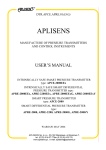
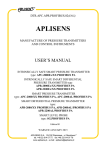
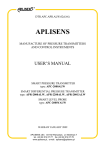
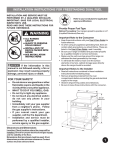
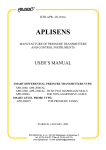
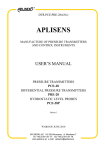
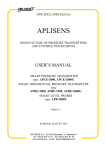

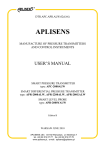
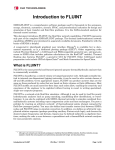
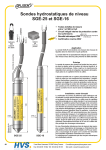
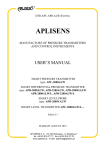
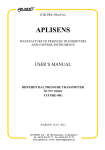
![[17] User`s Manual ver. 2.0.2](http://vs1.manualzilla.com/store/data/005765389_1-e376d351ef2708f30fcfdc5f98b9ba18-150x150.png)
